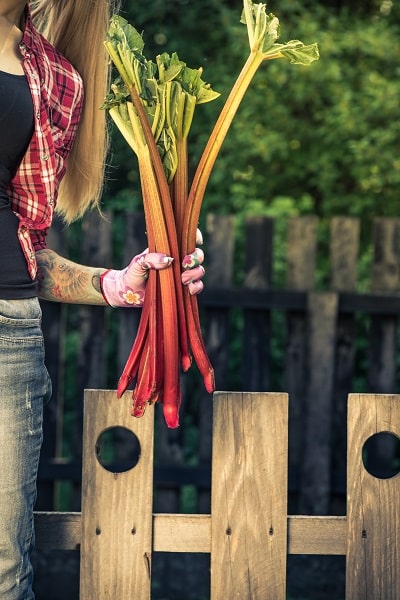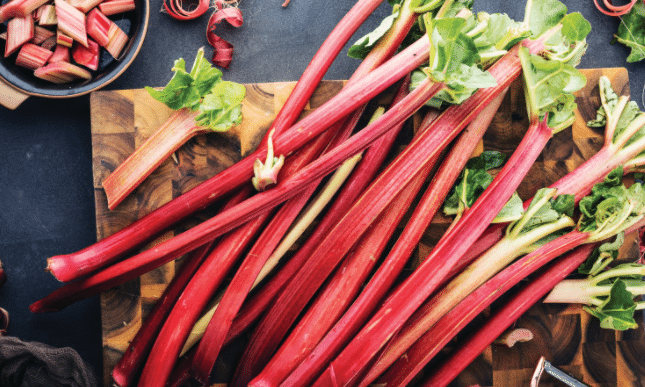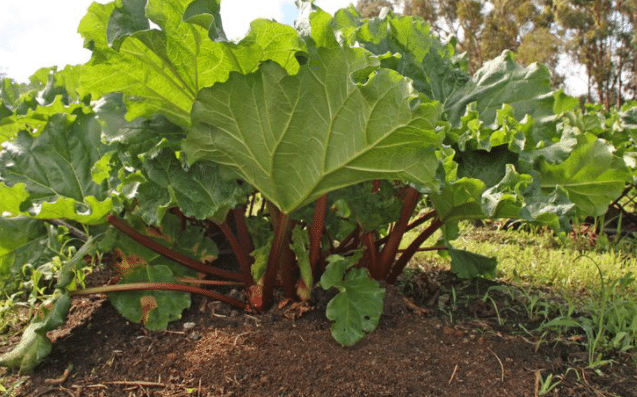Rhubarb is known for the delicious recipes of its red and green stalks. In North America and Europe, it is often cooked and made sweet. Asians prefer to use rhubarb leaves for medicines. However, what’s most important is growing this plant. So, here’s an A to Z of rhubarb plantation, from its growing season to harvesting.
Contents
Where Should You Look For Rhubarb?

You may look for a neighbor or friend with a large rhubarb patch at their place. They’ll surely share some with you. It’s easy to dig for rhubarb plants. Plus, you can even replant by dividing them. Use a sharp shovel to segregate the crown of rhubarb at the planting site. Then, select a portion with two stems or more. That’s all! Plant it a few inches below the soil for best results.If you cannot find rhubarb stalks at your neighbor’s, visit a local garden center. You will find these plants in spring as rhubarb’s growing season begins. Some sellers also have plant roots you can buy and create a rhubarb patch in the season.
Where To Grow Rhubarb Stalks?

While choosing the location for rhubarb plants, remember two things. First, find a permanent spot for this plant because it’s perennial. Rhubarb will grow more extensive in the years to come. However, the good part is you can divide them. Second, let the plant grow in a lot of light. Look for a spot with full sun. Since rhubarb is an attractive and tall plant, you may incorporate it within your landscape.
If you select a planting site, ensure that it’s large enough. Rhubarb plants spread between 3-4 feet wide. Always ensure the soil is made fertile with compost and dig a deep hole. Moisture is another essential element. So, ensure that the soil around rhubarb leaves stays hydrated. However, don’t let water remain stagnant on the soil surface as it causes root rot.
What Is Crown Rot?

Crown rot or root rot is a soil-borne fungus that stays in the soil. It occurs due to extreme wet conditions or heavy soils. Symptoms vary from one kind of rhubarb plant to another.
How To Troubleshoot Rhubarb Plant Diseases?

Root Rot
When soil drainage is poor, root rot happens. The terminal buds of flower stalks are damaged, resulting in weaker stems. One cure is to burn the infected part by digging some inches below the soil. Also, note that your planting site should be uninfected from crown rot in the past.
Leaf Spots
Another issue with rhubarb leaves is Leaf Spots. Ramularia or red leaf can ruin the stalks. To prevent this disease, cut away old foliage in winters.
Rhubarb Curculio
From late spring to early summer, insects puncture rhubarb leaves. It is known as rhubarb curculio. This disease occasionally attacks plants. The stems damaged by insects ooze sap and gradually decay. For more info, visit your garden center.
How To Care For Rhubarb?

Rhubarb plants do not require a lot of maintenance. Once planted, they grow every year in the spring season. However, your rhubarb stalks need a year to establish themselves. So, allow them. The soil around your plant must stay moist but not overloaded with water. Give them full sun, and after a year, you can harvest the stems. Once your raised beds mature, flower stalks will appear. Eventually, pink flowers grow. If your goal is rhubarb stalks and not mere landscape enhancement, don’t let the flower stalks grow. Now, the plant will invest its entire energy in growing rhubarb leaves.
Harvesting Rhubarb

The year you add rhubarb to your garden must not witness harvesting. Next year, you can cut the flower stalks and harvest lightly. But, from the third year onwards, you’re free to harvest rhubarb leaves and stems freely. Also, to ensure the production continues, never remove more than one-half the rhubarb stalks.
Here’s the harvesting process:
- Select twelve to eighteen inches long rhubarb stems, which should be Canada red in color.
- Hold the base of a rhubarb stalk and pull it up. You can twist the stem for smooth harvesting.
- One may even cut the stems using a sharp knife in the rhubarb patch.
- Cut close to the plant crown. Don’t damage it.
- Soon after harvesting rhubarb, remove the leaves and the base. You have the colored stalk.
Quick Tips On How To Grow Rhubarb

Here’s all about creating a rhubarb patch in a nutshell.
Growing season
Early spring is an excellent season for rhubarb plantation. These are cool days with the ground fertile.
Growth of rhubarb stalks
Growing rhubarb in full sun will result in a rich harvest in eight years. So, don’t disturb the planting site for a long time.
Spreading out and soil surface
Let your plant grow wide by keeping a 4-6 feet gap while creating a rhubarb patch. Then, add rich organic matter or 15 inches long compost to improve your soil surface.
Rhubarb plant in summers
Applying a two inches long layer of mulch for blocking weeds is a good idea. It keeps the soil moist.
Moisture in raised beds
If the top inch of the soil surface starts drying up, water your rhubarbs. Keep checking soil moisture regularly.
Feeding and harvesting rhubarb
Ensure that you’re feeding the raised beds continuously with plant food. Then, you may start harvesting rhubarb when the flower stalks are 12-18 inches long. The final color is Canada red.
How To Use Rhubarb?

Rhubarb leaves and stems are edible. The mouth-puckering sourness might trouble you. But, you can have them anytime with baked desserts and goods. Add some sugar. Let’s talk about rhubarb recipes.
Hungry? Grab A Rhubarb Meal
Rhubarb stalks make delicious recipes. A few you can include in your meals are rhubarb-strawberry pie, cheesecake, bread, and cakes. Just wash some stalks and dry them, then slice and bake. You may even make barbecues, salsas, and sauces with rhubarb. If you’re planning on making rhubarb recipes, do not forget lemonade slush and coffee cake. Get together any day and relish these rhubarb leaves delights.
Conclusion
Once you grow and harvest rhubarb, the last part is storage. Keep the rhubarb stalks covered in a plastic bag and a wet paper towel. If you store its stems in the fridge, they stay fresh for two weeks. Another way to save rhubarb for a year is to keep it frozen. You can chop and put the rhubarb slices in a sealed freezer bag. So, that’s all. Let the rhubarb plants grow in full sun, prevent rots, harvest, cook, and enjoy!